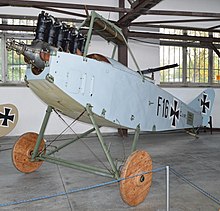Albatros CI
| Albatros CI | |
|---|---|

|
|
| Type: | Scouts, bombers |
| Design country: | |
| Manufacturer: | |
| First flight: |
1915 |
| Commissioning: |
1915 |
| Production time: |
1915-1918 |
The Albatros CI was a two-seater reconnaissance aircraft used by the German air force during the First World War .
development
Increasing air domination by Allied aircraft armed with machine guns over the front prompted Germany to introduce a new class of aircraft, the two-seater two-seater armed with machine guns, categorized as the C-class. The CI was the first two-seater model from Berlin's Albatros Flugzeugwerke that conformed to this design. Designer Robert Thelen designed the aircraft, although it was essentially a copy of the unarmed Albatros B.II ; What was decisive, however, was that the observer who had previously been seated in the front was now accommodated in a pulpit behind the pilot. Here he had a clear field of vision to the side and to the rear and was able to defend the aircraft effectively with his Parabellum machine gun mounted on a rotating ring mount .
Like the B.II, the CI had a two-legged structure and was driven by a 180 hp Argus As.III, a 150 hp Benz Bz. III or a 160 hp Mercedes D.III 6-cylinder engine. Aircraft delivered by Albatros could be seen with two side coolers at the height of the cockpit, while the aircraft manufactured under license received block coolers on the leading edge of the upper wing. The license manufacturer was initially LFG Roland , later the Märkische Flugzeugwerke (MFW) , the Bayerische Flugzeugwerke (BFW) and the Mercur Flugzeugbau GmbH were added. The training aircraft with double control manufactured by BFW and Mercur from 1917 onwards were named Albatros C.Ia (Bay) , Albatros C.Ib (Mer) and Albatros C.If (Mer) . A prototype with an extended three-legged structure was also built.
A type Albatros C.II - a pressure propeller version with 150 HP Bz. III engine - did not get beyond the experimental stage.
commitment
The first Albatros CI were delivered to the aviation departments at the end of April 1915; however, it and the LVG CI that followed shortly afterwards were more popular with the crews than the Aviatik CI with its cumbersome MG installation, which was delivered around the same time .
These aircraft of the new C-category could, in contrast to their unarmed predecessors, now also be used for reconnaissance and bombing missions beyond the enemy lines. The Albatros C aircraft demonstrated the same good flight characteristics as the B.II; In addition, they could carry bombs up to 70 kg in a drop shaft between the observer's cockpit and the pilot's cockpit for combat missions. The CI also proved itself in air combat: Oswald Boelcke and Manfred Freiherr von Richthofen achieved their first aerial victories with the Albatros CI
The allied Turkish and Bulgarian air forces also received Albatros CI
When the CI was replaced by the Albatros C.III towards the end of 1916 , the CI experienced a second heyday in its career as a training aircraft due to its good-natured flight characteristics.
Post-war use
After the war the Albatros CI received the civil trade name L.6. Some CI continued to serve in the air forces of Lithuania , Poland and Sweden for a while . The world's only surviving Albatros CI is located in the Polish Aviation Museum in Krakow .

Technical data Albatros CI
| Parameter | Data |
|---|---|
| crew | 2 |
| length | 7.85 m |
| span | 12.90 m |
| height | 3.14 m |
| Wing area | 40.4 m² |
| Empty mass | 875 kg |
| Takeoff mass | 1190 kg |
| Engine | an in- line engine Argus As III , 180 PS (132 kW) or a Mercedes D III , 160 PS (118 kW) or a Benz Bz III , 150 PS (110 kW) |
| Top speed | 135–140 km / h (depending on the engine) |
| Climbing time to 1000 m | 9:45 min |
| Climbing time to 2000 m | 25 min |
| Ascent time to 3000 m | 58 min |
| Service ceiling | 3000 m |
| Range | 380 km |
| Flight duration | 2:30 h |
| Armament | 1 MW 7.92 mm; 70 kg bombs |
See also
literature
- G. Kroschel: The German military aircraft 1910-1918 . Lohse-Eissing, Wilhelmshaven 1977, pp. 67, 150, 160.
- Kenneth Munson: Bomber 1914-1918 . Orell Füssli, Zurich 1968, p. 109.
- Heinz Nowarra: The Development of Airplanes 1914–1918 . Lehmanns, Munich 1959.
Web links
Individual evidence
- ↑ a b J. Rickard: Albatros CI In: HistoryOfWar.org. October 3, 2012, accessed September 8, 2015 .